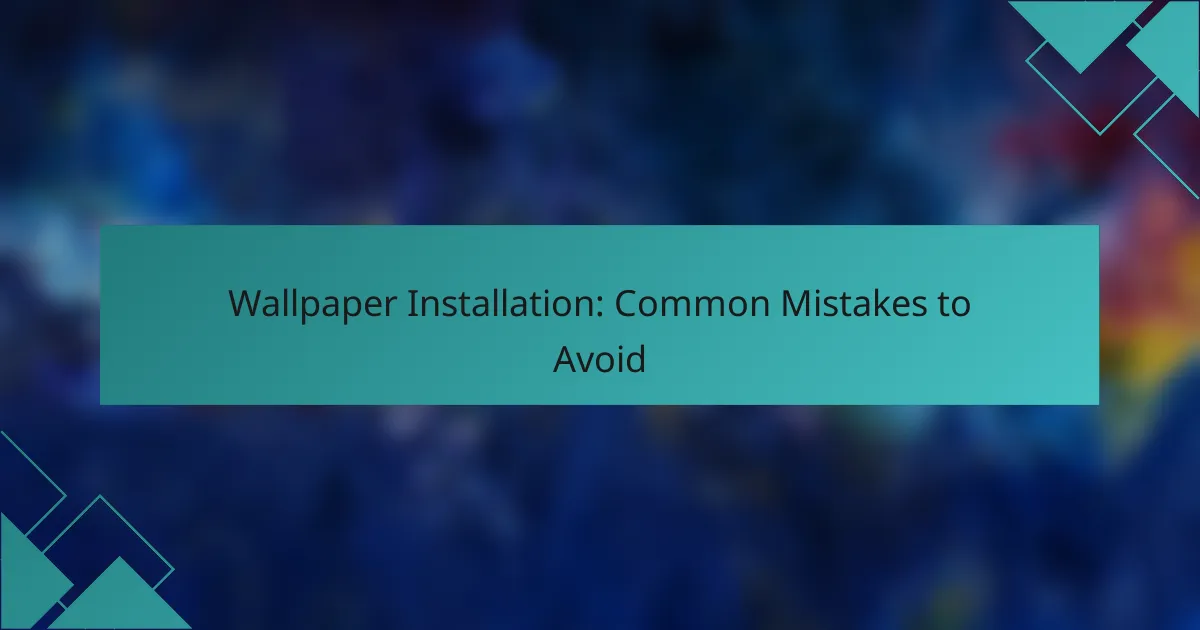Wallpaper installation can transform a space, but common mistakes can lead to disappointing results and wasted materials. By focusing on proper surface preparation, accurate measurements, and the right adhesive, you can avoid pitfalls that compromise your project. Taking the time to execute each step carefully will ensure a beautiful and lasting finish.
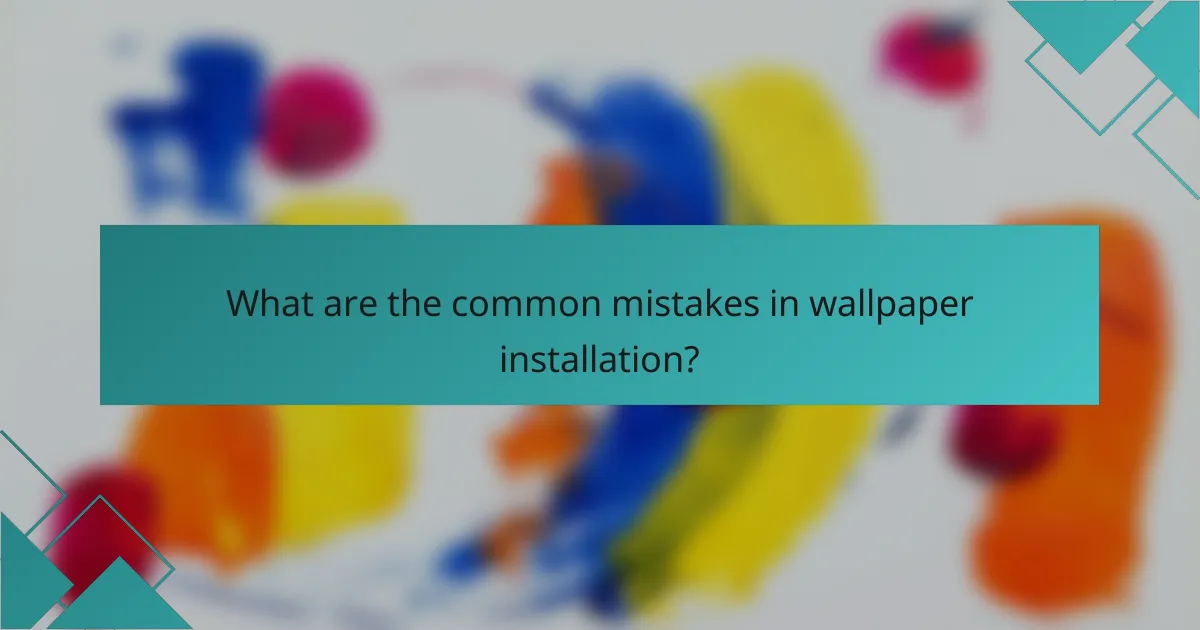
What are the common mistakes in wallpaper installation?
Common mistakes in wallpaper installation can lead to unsatisfactory results and wasted materials. Key errors include improper surface preparation, incorrect pattern alignment, using the wrong adhesive, neglecting accurate measurements, and ignoring environmental factors like temperature and humidity.
Improper surface preparation
Before applying wallpaper, the surface must be clean, smooth, and dry. Failing to remove old wallpaper, dirt, or grease can prevent the new wallpaper from adhering properly, leading to peeling or bubbling. Always sand rough patches and fill in any holes or cracks to ensure a flat surface.
Consider using a primer specifically designed for wallpaper. This can enhance adhesion and create a more uniform base, especially on porous or textured surfaces.
Incorrect alignment of patterns
Aligning wallpaper patterns incorrectly can result in a disjointed appearance that detracts from the overall look. Always start from a plumb line or reference point and ensure that patterns match at seams. This is particularly crucial for patterned wallpapers, where misalignment can be glaringly obvious.
Take your time during the initial placement. A small adjustment at the beginning can save significant rework later on. Use a level or laser guide to maintain straight lines throughout the installation.
Using the wrong adhesive
Choosing the incorrect adhesive can lead to wallpaper failure, such as peeling or bubbling. Different types of wallpaper require specific adhesives; for example, vinyl wallpapers typically need a stronger adhesive than paper ones. Always check the manufacturer’s recommendations before starting.
Additionally, consider the conditions of the room. For high-humidity areas like bathrooms, a moisture-resistant adhesive is essential to ensure longevity and performance.
Neglecting to measure accurately
Accurate measurements are crucial for a successful wallpaper installation. Failing to measure walls properly can result in insufficient material, leading to mismatched patterns or incomplete coverage. Always measure each wall individually, accounting for windows and doors.
As a rule of thumb, add an extra 10% to your total wallpaper order to accommodate for mistakes or pattern matching. This ensures you have enough material to complete the job without delays.
Ignoring temperature and humidity
Temperature and humidity can significantly affect wallpaper adhesion and longevity. Ideal conditions for installation are typically between 18-24°C (65-75°F) with moderate humidity levels. Extreme temperatures or high humidity can cause the adhesive to fail or the wallpaper to warp.
Before starting, check the room’s conditions and adjust as necessary. If the environment is too humid, consider using a dehumidifier or waiting for a more suitable day to install your wallpaper.
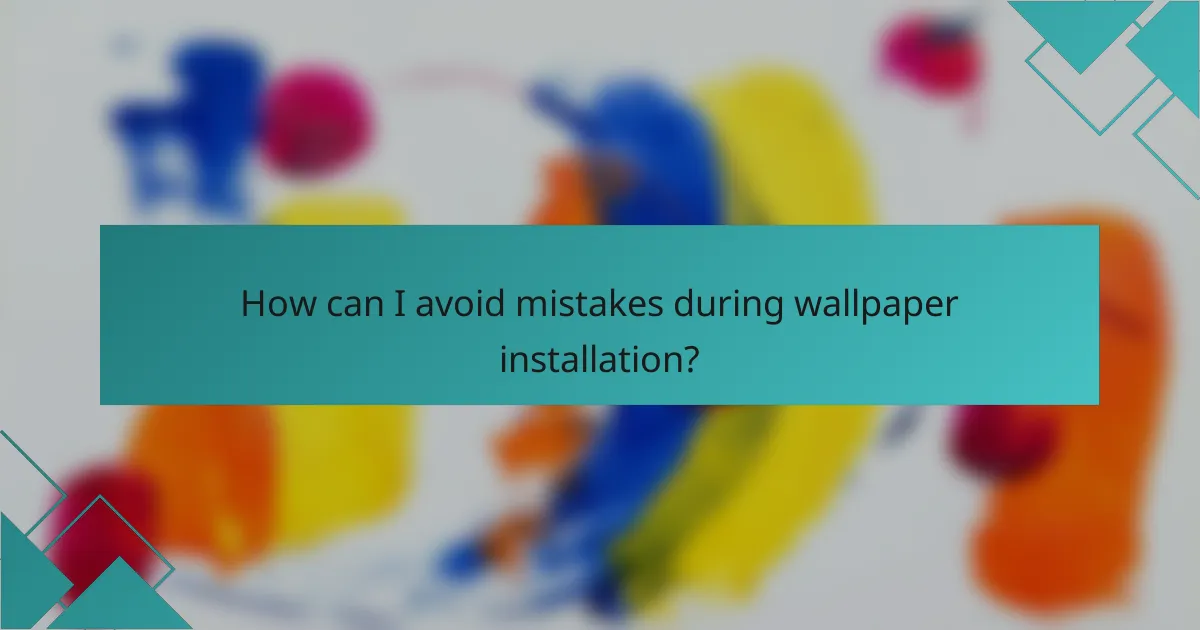
How can I avoid mistakes during wallpaper installation?
To avoid mistakes during wallpaper installation, focus on proper preparation and careful execution. Taking the time to clean surfaces, use the right tools, and monitor conditions can significantly enhance the outcome of your project.
Thoroughly clean and prime surfaces
Cleaning and priming surfaces before wallpaper installation is crucial for adhesion and longevity. Dust, grease, and imperfections can prevent the wallpaper from sticking properly, leading to peeling or bubbling.
Use a mild detergent solution to clean the walls, and allow them to dry completely. Applying a primer designed for wallpaper can create a smoother surface and improve adhesion, especially on porous or textured walls.
Use a level for pattern alignment
Using a level ensures that your wallpaper patterns align correctly, creating a professional appearance. Even slight misalignments can become more noticeable as you progress, so starting straight is essential.
Mark a vertical line on the wall using a level and a pencil, then align the first strip of wallpaper with this line. This method helps maintain consistent alignment throughout the installation process.
Select the right adhesive for your wallpaper
Choosing the correct adhesive is vital for a successful wallpaper installation. Different types of wallpaper require specific adhesives, such as paste-the-wall or paste-the-paper options.
Read the manufacturer’s instructions to determine the best adhesive for your wallpaper type. Using the wrong adhesive can lead to issues like poor adhesion or damage to the wallpaper when removing it.
Measure twice, cut once
Accurate measurements are essential to avoid waste and ensure a proper fit. Measure the height and width of each wall section where wallpaper will be applied, and account for any patterns that need matching.
Cut wallpaper strips slightly longer than needed to allow for adjustments. This practice minimizes the risk of cutting too short and having to start over.
Monitor environmental conditions
Environmental conditions can significantly impact wallpaper installation and drying times. Ideal conditions include a temperature range of 18-24°C (65-75°F) and moderate humidity levels.
Avoid installing wallpaper in extreme temperatures or high humidity, as these factors can affect adhesion and cause the wallpaper to warp. If necessary, use fans or dehumidifiers to create a suitable environment for installation.
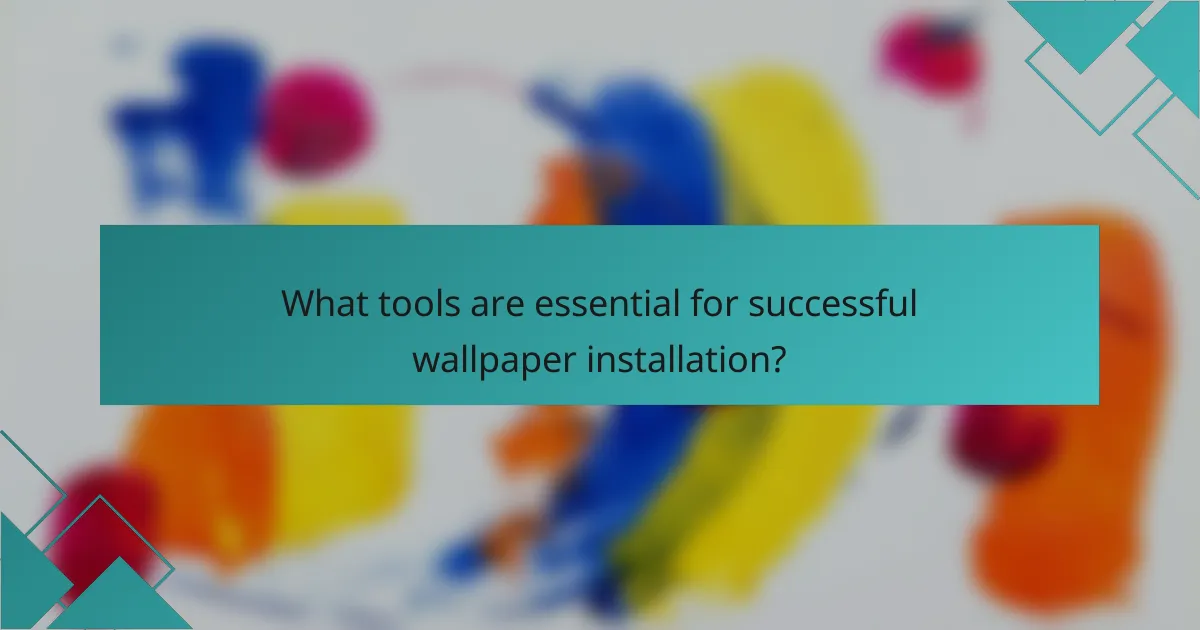
What tools are essential for successful wallpaper installation?
Successful wallpaper installation requires a few essential tools to ensure a smooth and professional finish. Having the right equipment can significantly reduce errors and improve the overall quality of the project.
Wallpaper smoother
A wallpaper smoother is a flat tool used to eliminate air bubbles and wrinkles during installation. It typically has a rounded edge to prevent damage to the wallpaper while applying pressure.
When using a wallpaper smoother, start from the center of the panel and work your way outward. This technique helps push out trapped air and ensures a tight bond with the wall.
Utility knife
A utility knife is crucial for trimming excess wallpaper at the edges and around fixtures. It provides a clean cut, which is essential for a professional appearance.
Always use a sharp blade to avoid tearing the wallpaper. Replace the blade regularly to maintain precision and reduce the risk of damaging the wallpaper or the wall itself.
Measuring tape
A measuring tape is vital for accurately measuring wall dimensions and wallpaper lengths. Precise measurements help prevent waste and ensure a seamless fit.
When measuring, always account for patterns in the wallpaper. Take multiple measurements to confirm accuracy, especially in rooms with irregular shapes or features.
Level
A level is essential for ensuring that your wallpaper is applied straight. An uneven application can lead to noticeable seams and an unprofessional look.
Use the level to check the first strip of wallpaper before applying it. Adjust as necessary to ensure that subsequent strips align perfectly with the first.
Seam roller
A seam roller is used to press down the edges of wallpaper strips to ensure they adhere properly. This tool helps to prevent lifting and creates a smooth finish at the seams.
When using a seam roller, apply gentle pressure along the seams after installation. This step is crucial for achieving a seamless look and preventing future peeling.
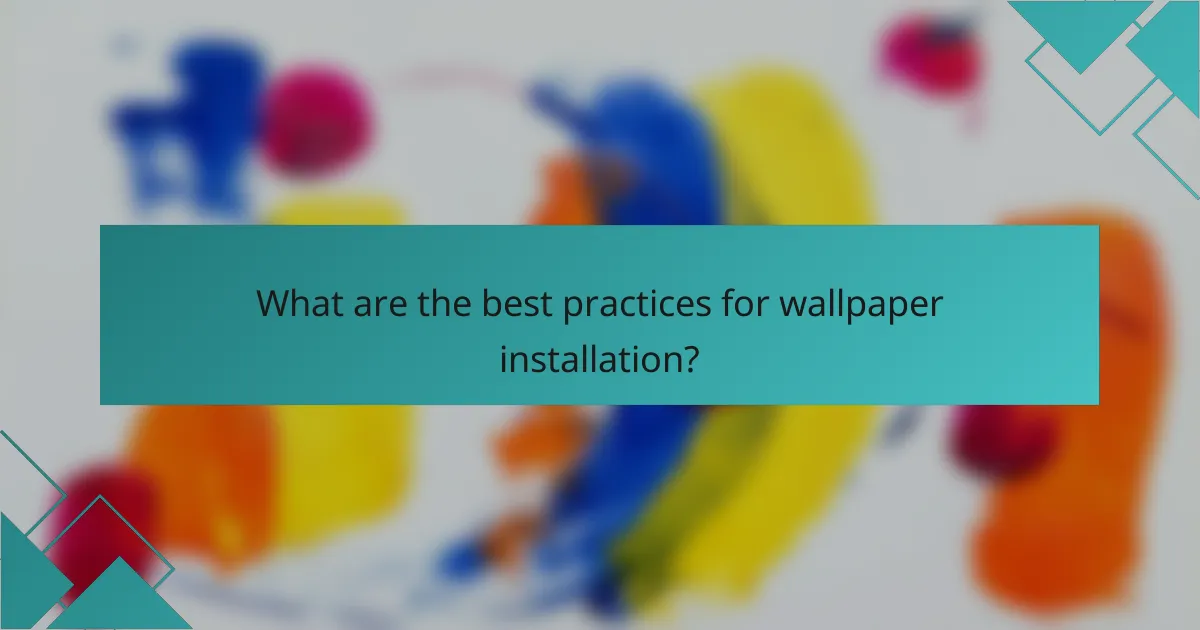
What are the best practices for wallpaper installation?
To achieve a successful wallpaper installation, follow best practices that ensure proper adhesion and alignment. Key practices include adhering to manufacturer instructions, working in manageable sections, using a plumb line for vertical alignment, and allowing the wallpaper to acclimate before installation.
Follow manufacturer instructions
Each wallpaper type comes with specific guidelines from the manufacturer that dictate how to prepare the wall, apply adhesive, and hang the paper. Following these instructions closely can prevent issues such as bubbling, peeling, or misalignment.
Check for details regarding the type of adhesive to use, recommended tools, and drying times. Ignoring these instructions can lead to costly mistakes and a less-than-professional finish.
Work in sections
Dividing the wall into sections makes the installation process more manageable and helps maintain alignment. Start with a small area, typically around one to two strips wide, to ensure accuracy and control over the application.
By working in sections, you can focus on smoothing out each piece before moving on, reducing the risk of mistakes and allowing for adjustments as needed. This approach is especially useful in larger spaces or when using intricate patterns.
Use a plumb line for vertical alignment
Using a plumb line is essential for ensuring that your wallpaper hangs straight. This tool helps establish a vertical reference point, which is crucial when starting the first strip of wallpaper.
To use a plumb line, simply hang it from the ceiling to the floor at your starting point. Align the first strip of wallpaper with this line to ensure that all subsequent strips remain straight and evenly spaced.
Allow wallpaper to acclimate
Before installation, allow the wallpaper to acclimate to the room’s temperature and humidity for at least 24 hours. This step helps prevent expansion or contraction after it’s applied, which can lead to wrinkles or gaps.
Store the wallpaper in the room where it will be installed, laying it flat or hanging it on a wall. This practice ensures that the material adjusts properly to the environment, resulting in a smoother application and better adhesion.
